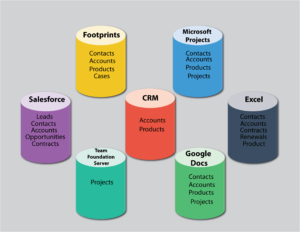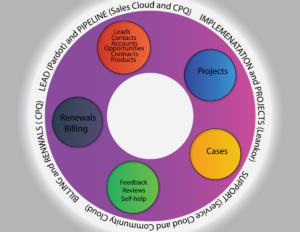

Relying upon the use of many different applications causes information gaps and prevents accurate and timely communication with customers. This, in turn, decreases efficiency among employees, and creates missed chances for continued upsells. The post below can help you consolidate data with Salesforce.
The opportunity to migrate completely from or reduce the reliance of many different applications to one application, Salesforce, will improve your company’s current business processes by allowing for an accurate view of customer relationships, giving your company quality tools that integrate with one system, increasing data accuracy and eliminating duplicate data, and securing data from public shared systems. Read on to find out how to consolidate data with Salesforce.
Salesforce will solve the following problems:
- Lack of visibility to customer communications
- Lack of quality tools that integrate with one system
- Data inaccuracy and duplication
- Unsecured data from shared documents
Keep reading this post to see a real-life example of how you can consolidate data with Salesforce.
Lack of Visibility to Customer Communications
The biggest problem currently caused by multiple systems is the inability to view real-time customer communication. Customer satisfaction and feedback are extremely important, because customers provide a main source of innovation.
If currently, your customer data is in several different places, this data can be very inefficient to manage. For example, some customers use Footprints, CRM, Sales Cloud, Microsoft Projects, Google Docs, and Excel. Customer data starts out in Sales Cloud, but the data in Sales Cloud is mainly excluded to decision makers and those involved in the buying process. Operations may then add administrators and other user data to Microsoft Projects or Google Docs, and Client Services may add them to Footprints when they open tickets as customers. Other customer information such as lease and product data are in CRM.
For one department to see a holistic view of customer data, it would need to log into and search for this data in all six systems. If the data is in Excel, the specific file may be especially hard to find. No department currently logs into all six systems, leading to the following barriers:
- Marketing and Sales cannot see customer product data, so they cannot market its other products to customers.
- Marketing does not have the contact information for all administrative and user customers, so it cannot send Product Announcements/Server Maintenance Notifications to all parties, excluding some customers.
- Sales cannot see open and closed cases, so it cannot tell current customer satisfaction. This limits visibility into opportunity forecasting and creates missed chances for upsells.
- Customer Service cannot see customer interaction in Microsoft Projects, Google docs, or Excel so it misses important information gathered during implementation.
By switching to Salesforce apps, each department can view customer data in Salesforce and have a holistic view of our customer data and current customer satisfaction. Sales and Marketing can view when customer relations are positive and propose upsells, or Client Services can know when customers are upset and quickly address issues. Marketing can make sure that all customers get Product Announcements/ Server Maintenance Notifications, leading to happier and better-informed customers.
In addition, by migrating to Community Cloud, you will have a customer portal, a place where customers can leave feedback, suggest product improvements, and learn from other customers. Customer feedback in Community Cloud will also give Products and Application Development ideas for software innovation. The addition of Community Cloud can decrease total call and email volume as customers utilize self-help through Knowledge Base articles.
Lack of Quality Tools that Integrate into One System
Multiple systems also cause inefficiency among and within departments. Most businesses are composed of Marketing, Sales, Customer Service, Operations, Accounting, Product/Service Development, and IT. Each department uses different applications, as follows:
- Sales and Marketing may use Salesforce, specifically using Sales Cloud and Pardot, CRM, and Excel
- Customer Service may use Salesforce, specifically implementing Service Cloud and Community Cloud, but currently uses CRM and Footprints
- Operations may use Microsoft Projects and Google Docs
- Accounting may use Excel and Oracle
- Product/Service Development may use Team Foundation Server, but are testing out the effectiveness of using free third-party apps
Many departments spend many unnecessary hours trying to get information from one another. Sales spends time trying to get new proposal/contract information from Salesforce, CRM, and Excel. Marketing spends time obtaining and updating customer information from Footprints and Excel. Sales spends time getting customer cases information from Footprints. Customer Service spends time getting project updates from Microsoft Projects and Google Docs.
Operations, Product/Service Development need to spend long hours on numerous project status updates and on finding new resources. They need an ERP system with effective Gantt Charts, project dashboards and calendars, and resource management tools.
The following Salesforce features and apps can save time and increase efficiency:
- CPQ allows Sales to generate quotes and proposals from existing contact, opportunity, and product information in Salesforce. These proposals are converted into contracts. These contracts are then stored in Salesforce for each department (especially IT and Accounting) to have access at their convenience. This eliminates the need for hours of tedious and manual Excel updates. An electronic version of the contract is also stored in Salesforce for easy renewal updates and future access.
- Service Cloud gives Marketing real-time view of any customers recently added and removed. It also gives Sales access to cases status, case owners, and case details. This eliminates the need for Sales and Client Services to schedule meeting times with each other and frees up time for other customer-related tasks.
- Leankor allows Implementation to manage their projects and resources and update customer data directly from Salesforce, so that Customer Service has direct visibility to project status, updates, and any added contact information. Consultants can easily update projects via Kanban, and their project statuses are quickly and accurately reflected, eliminating the need for project status updates. Managers can view available human resources from the project, portfolio, and customer levels, allowing for multiple levels of resource management.
- Quip allows Implementation to share files with one another, and all data directly integrates with Salesforce. Customer Service and any other collaborating departments can easily view and edit the documents, on the computer or on their phones; online or offline; via the document directly or through Quip’s chat feature.
Using Salesforce apps would also increase efficiency within all departments by using Inbox. Inbox is an email and calendar Salesforce feature, which sends calendar invites with real-time updates, so that no time is wasted scheduling and rescheduling. Users can add email details to virtually any and multiple Salesforce objects including leads, contacts, accounts and opportunities.
Data Inaccuracy and Duplication
Multiple systems also increase the likelihood for data duplication, leading to inaccuracy. In addition, one department may update data in one system, but leave old data in another. The most common scenarios are as follows:
- Customer product purchases and lease information may be initially accurate in Salesforce, but is not consistently updated. The information is the more accurate in CRM and in the contract handled by Accounting. Because there are multiple systems that house product information, there is also a lack of accountability to keep data accurate in one system. One department may not even be able to see which customers have which products. This would affect service level agreements with the customers and their ability to assist customers with their account questions.
- Customer contact information may be initially accurate in Salesforce, but over time, Customer Service may only update the information in Footprints and not in Salesforce. Because of this, relevant marketing emails and product announcements do not reach all recipients. This would hurt customer relationships due to the lack of communication.
- Each department is also wasting hours on duplicating this data, leading to inefficiency and increased likelihood for lost data. For example, the same Sales person needs to write out a proposal in Excel, update the contract information in Word or PDF, and input some information into Salesforce and some information into CRM. Sales may have other left data in their emails. Entering data in so many different places could cause Sales to give a different quote than what was originally communicated to the prospect, which may upset the prospect and end a deal.
- There is an inability to produce beneficial reports needed to show current progress and improvements needed. The following reports are pertinent:
- Response time for cases: Customer Service needs better and more unified data when creating reports related to cases response times.
Using Salesforce would lessen duplication and increase data accuracy and accountability towards the users entering the data. Customer lifecycle would exist only in Salesforce. All departments would expect to see and be able to see the most accurate real-time customer information. For one customer, there would only be one email, one lease number, one list of products, etc. Marketing would enter lead information, and then Sales would convert the information into contacts, proposals, contracts, and opportunities. Implementation and Customer Service would enter in non-buyer and administrator contacts, Accounting would update contract, billing, and renewal information, and customers would be sent back to Marketing and Sales for upsells, all within Salesforce. By using Salesforce Sales and Service Cloud, Marketing can run more accurate customer reports, since Customer Service and Operations, who work directly with customers, would be entering customer information directly in Salesforce. Customer Service will also be able to pull needed reports related to case response time, close rate, ownership, and entitlement management. By having all data in one system, you can pull more accurate trending and progress reports, because of the holistic and correct customer data.
Unsecured Data on Personal Computers
By using Google Docs and other unsecured document sharing platforms, your company puts itself at risk. Sensitive data stored on Google Docs is more viable to being stolen, which could cost thousands of dollars to recover. In addition, when employees transition from the company, data stored in these places may be hard to find or lost.
Salesforce’s Quip makes team collaboration on company documents safer. Quip uses Salesforce’s organization security for any uploaded documents.
Salesforce will improve your company’s current business processes by allowing for an accurate view of customer relationships, giving your company quality tools that integrate with one system, increasing data accuracy and eliminating duplicate data, and securing data from public shared systems.
What are you waiting for? Start to consolidate data with Salesforce today!
Learn more about Salesforce
See Digital Marketing Techie’s other Salesforce for marketers resources:
Aligning Marketing and Sales Using Salesforce Lead Lifecycle Reporting
Cracking the Code on Salesforce Campaign and Multiple Campaign Influence Reporting
